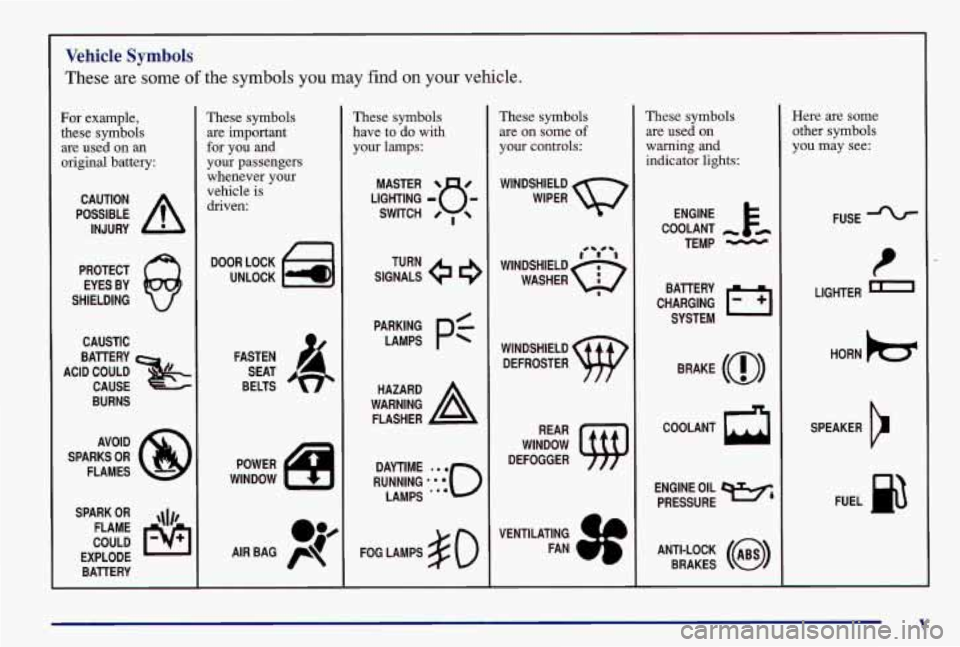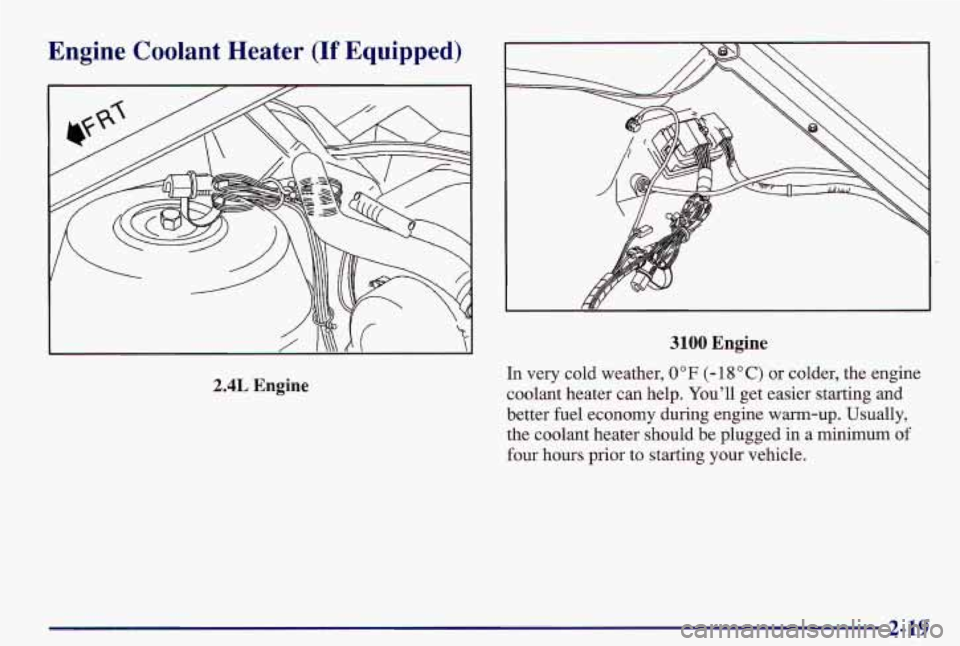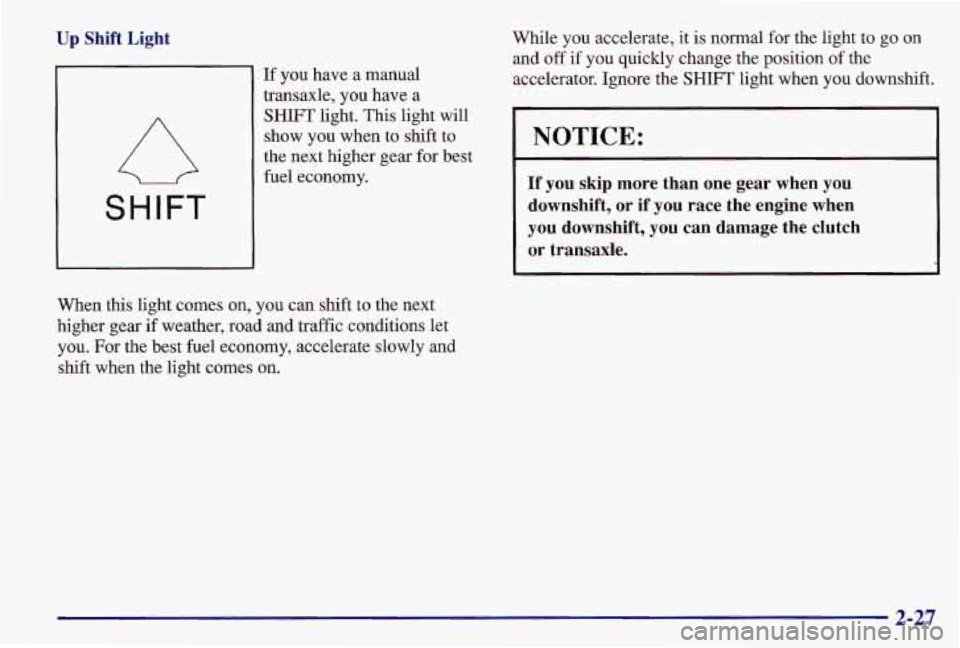1997 PONTIAC GRAND AM fuel
[x] Cancel search: fuelPage 6 of 371

Vehicle Symbols
These are some of the symbols you may find on your vehicle.
For example,
these symbols are used on
an
original battery:
POSSIBLE A
CAUTION
INJURY
PROTECT EYES BY
SHIELDING
CAUSTIC
ACID COULD BATTERY
CAUSE
BURNS
SPARK
OR ,\I/,
COULD FLAME
EXPLODE BA'ITERY
These symbols
are important
for you and
your passengers whenever your
vehicle is
driven:
DOOR LOCK
UNLOCK
FASTEN SEAT
BELTS
These symbols
have to do with
your lamps:
SIGNALS e
TURN
FOG LAMPS
$0
These symbols
are on some
of
your controls:
WINDSHIELD
WIPER
WINDSHIELD DEFROSTER
These symbols
are used
on
warning and
indicator lights:
COOLANT -
TEMP -
CHARGING I-1
BA'ITERY
SYSTEM
BRAKE
(a)
COOLANT a
ENGINE OIL w,
PRESSURE
ANTI-LOCK
(@)
BRAKES
Here are some
other symbols
you may see:
FUSE -%-
t
LIGHTER n
HORN )tr
SPEAKER
b
FUEL m
V
Page 66 of 371

Remote Trunk Release
The remote trunk release handle is located on the floor
near the left side of the driver’s seat in front of the
fuel door release. Pull up on the remote release handle to
release the trunk lid. Make sure the override feature is
not activated.
Trunk Security Override
The remote trunk release is
equipped with an override
feature to help prevent
unauthorized entry into the
trunk when leaving the
vehicle unattended, The switch is located on the
inside of the trunk lid,
mounted to the trunk
lid latch.
To turn the override feature on, slide the switch all the
way to the right. To turn the override feature off, slide
the switch all the way to the left.
When the override is on, the mechanical remote trunk
release will not release the trunk lid, However, the
trunk
lid can still be opened with the key.
This lockout feature
is only available on vehicles that do
not have the Keyless Entry System.
2-11
Page 68 of 371

Passlock TM
Your vehicle is equipped with the Passlock
theft-deterrent system.
Passlock is a passive theft-deterrent system. The system is
armed once the key is removed from the ignition. Passlock
enables fuel if the ignition lock cylinder is turned with a valid key.
If a correct key is not used, fuel is disabled,
During normal operation, the THEFT SYS light will go
off after the engine is started. If the engine stalls and the
THEFT SYS light flashes, wait until the light stops
flashing before trying to restart the engine. Remember to
release the key from the START position as soon as the
engine starts. If you are driving and the THEFT
SYS
light comes on, you will be able to restart the engine if
you turn the engine off. However, your Passlock system
is not working properly and must be serviced by your
dealer. Your vehicle is not protected by Passlock at this
time.
You may also want to check the fuse (see “Fuses
and Circuit Breakers” in the Index). See your Pontiac
dealer for service.
If the THEFT SYS light comes on while the engine is
running,
a problem has been detected and the system
may need service. See your dealer for service.
In an emergency, call the Pontiac Roadside Assistance
Center at 1-800-ROADSIB or 1-800-762-3743.
New Vehicle “Break-InSS
NOTICE:
Your modern Pontiac doesn’t need an elaborate
“break-in,” But it will perform better in the long
run
if you follow these guidelines:
0
0
0
Don’t drive at any one speed -- fast or
slow
-- for the first 500 miles (805 km).
Don’t make full-throttle starts,
Avoid making hard stops for the first
200 miles (322 km) or so, During this time
your new brake linings aren’t yet broken
in. Hard stops with new linings can mean
premature wear and earlier replacement.
Follow this breaking-in guideline every
time you get new brake linings,
Don’t tow
a trailer during break-in,
See “Towing a Trailer” in the Index for
more information.
2-13
Page 74 of 371

Engine Coolant Heater (If Equipped)
2.4L Engine
3100 Engine
In very cold weather, 0 OF (- 18 O C) or colder, the engine
coolant heater can help. You’ll get easier starting and
better fuel economy during engine warm-up. Usually,
the coolant heater should be plugged in a minimum
of
four hours prior to starting your vehicle.
2-19
Page 78 of 371

AUTOMATIC OVERDRIVE (D): This position is for
normal driving with the four-speed automatic transaxle.
If you need more power for passing, and you’re:
0 Going less than about 35 mph (55 km/h), push your
Going about 35 mph (55 km/h) or more, push the
The transaxle will automatically shift down
to the next
gear
and provide more power.
accelerator pedal about halfway down.
accelerator all
the way down. THIRD
(3): This position
is also used for normal
driving, however, it offers more power and lower fuel
economy than AUTOMATIC OVERDRIVE (D). Here are some times you might choose THIRD
(3) instead of
AUTOMATIC OVERDRIVE (D):
0 When driving on hilly, winding roads.
When towing a trailer, so there is less shifting
When going down a steep hill.
between gears.
I NOTICE:
This NOTICE applies
only if you have an
automatic overdrive transaxle.
If your vehicle is
so equipped and if it seems to start up rather
slowly, or if it seems not to shift gears
as you go
faster, something may be wrong with a transaxle
system sensor.
If you drive very far that way,
your vehicle can be damaged.
So, if this happens,
have your vehicle serviced right away. Until then,
you can use SECOND
(2) when you are driving
less than
35 mph (56 km/h) and AUTOMATIC
OVERDRIVE
(@) for higher speeds.
2-23
Page 79 of 371

SECOND (2): This position gives you more power but
lower fuel economy. You can use SECOND
(2) on hills.
It can help control your speed as you go down steep
mountain roads, but then you would also want to use
your brakes off and
on.
NOTICE:
Don’t drive in SECOND (2) for more than
25 miles (41 km), or at speeds over 55 mph
(88 km/h), or you can damage your transaxle.
Use AUTOMATIC OVERDRIVE
(@) or
THIRD
(3) as much as possible. Don’t shift into
SECOND
(2) unless you are going slower than
65 mph (105 km/h) or you can damage
your engine.
With automatic overdrive, SECOND
(2) will select
either first or second gear depending on vehicle speed.
If
your vehicle is slowing, the transaxle will downshift to
first gear at
20 to 25 miles per hour (32 to 40 km/h) for
engine braking. You may notice some variation in shift
speed in SECOND
(2) when accelerating or braking. FIRST
(1): This position gives
you even more power
(but lower fuel economy) than SECOND
(2). You can
use it on very steep hills, or in deep snow or mud.
If the
selector lever is put in
FIRST (l), the transaxle won’t
shift into first gear until the vehicle is going slowly
enough.
I NOTICE: 1
If your front wheels can’t rotate, don’t try to
drive. This might happen if you were stuck in
very deep sand or mud or were up against
a solid
object.
You can damage your transaxle.
~ Also, if you stop when going uphill, don’t hold
your vehicle there with only the accelerator
pedal. This could overheat and damage the
transaxle. Use your brakes or shift into PARK
(P)
to hold your vehicle in position on a hill.
2-24
Page 82 of 371

Up Shift Light
SHIFT
If you have a manual
transaxle, you have
a
SHIFT light. This light will
show you when to shift to
the next higher gear for best
fuel economy.
When this light comes on, you can shift
to the next
higher gear if weather, road and traffic conditions let
you. For the best fuel economy, accelerate slowly and
shift when the light comes on. While
you accelerate, it is normal for the light to
go on
and off
if you quickly change the position of the
accelerator. Ignore the
SHIFT light when you downshift.
IOTICE:
If you skip more than one gear when you
downshift, or if you race the engine when
you downshift, you can damage the clutch
or transaxle.
2-27
Page 99 of 371

Daytime Running Lamps
Daytime Running Lamps (DRL) can make it easier for
others to see the front
of your vehicle during the day.
DRL can be helpful in many different driving
conditions, but they can be especially helpful in the
short periods after dawn and before sunset.
The DRL system will make your high-beam headlamps
come on at a reduced brightness when:
The engine is running,
0 The headlamp switch is in the OFF position,
The light sensor detects daytime light,
0 The parking brake is released and
The shift lever is not in PARK (P) on an
automatic transaxle.
When the DRL system is on, the taillamps, sidemarker,
park lamps
and instrument panel lights will not be
illuminated.
The DRL and the ALC systems will remain off any time
your automatic transaxle vehicle is in PARK (P) and the
parking brake is engaged.
The DRL and the ALC systems will remain
off any time
your manual transaxle vehicle is in NEUTRAL (N) and
the parking brake is engaged.
Automatic Light Control (ALC)
Your vehicle is equipped with an automatic light sensor
on top of the instrument panel under the defroster grill,
so be sure it is not covered which will cause the
nighttime lights to be on continuously.
When it is dark enough outside, your ALC will turn
on
your low-beam headlamps at the normal brightness
along with other lamps such as the taillamps,
sidemarker, park lamps and instrument panel lights.
There is a 20-second delay in the transition between
daytime and nighttime operation
of the DRL and the
ALC systems.
If the light sensor senses a reduction in
lighting that lasts longer than
20 seconds, it will activate
the nighttime lamps. If you are driving through a
parking garage, heavy overcast weather, a tunnel or
fueling your vehicle in a low light area, the ALC will
turn on your low-beam headlamps at a normal
brightness along with the taillamps, sidemarker, park
lamps and the instrument panel lights. The radio lights
will be dimmer.
As with any vehicle, you should turn on the regular
headlamp system when you need
it.